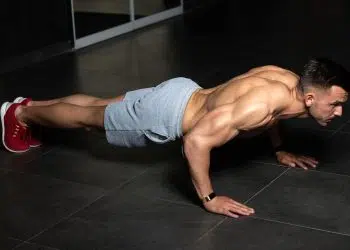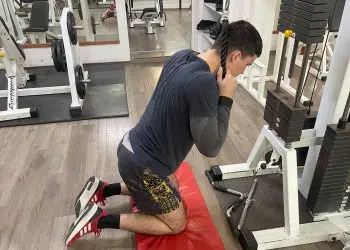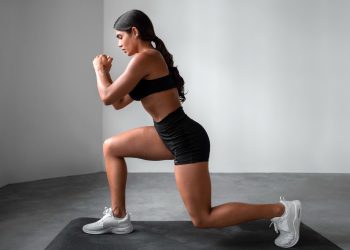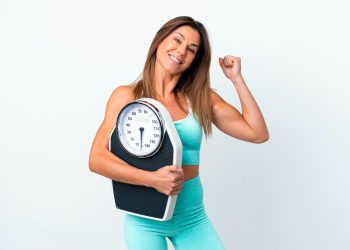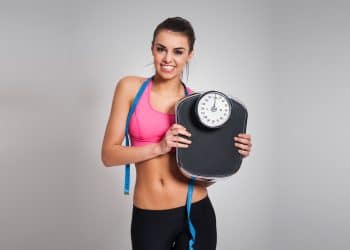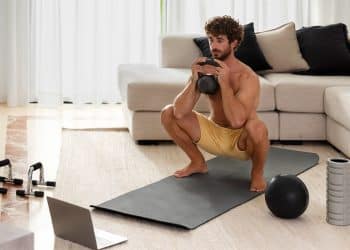The hanging straight leg raise is a body weight based movement used to build muscle and strength in the abdominal muscles of the core.
This specific (straight leg) variation is ideal for those who have decent core strength as the weight of extended legs provides a tough but incredibly effective workout.
In this guide, we’ve provided exercise instructions, plus tips, variations, and more.
In This Exercise
- Target Muscle Group: Rectus Abdominis/ core muscles
- Type: Hypertrophy, strength, function
- Mechanics: Compound
- Equipment: Bar to hang from
- Difficulty: Intermediate
Muscles Worked
While the core muscles are the primary target of the hanging straight leg raise, this exercise works several muscles. To maximize the effectiveness of any movement, it’s helpful to understand what muscles are involved, and we’ve provided a short description of each one.
Adductor Brevis
The adductor brevis is one of the adductor muscles that helps to pull the thigh medially (inward). It also helps to stabilize the trunk during certain movements, maintaining balance, and flexion of the thigh.
Adductor Longus
The adductor longus is another hip adductor muscle of the inner thigh. Therefore, it also pulls the thigh inward. Along with the adductor brevis and magnus it’s one of the strongest muscles of the thigh.
Level Up Your Fitness: Join our 💪 strong community in Fitness Volt Newsletter. Get daily inspiration, expert-backed workouts, nutrition tips, the latest in strength sports, and the support you need to reach your goals. Subscribe for free!
Iliopsoas
The iliopsoas is the primary hip flexor; made up of the major and minor psoas muscles and the iliacus muscle. It can function as a unit or separately to stabilize and facilitate movement. These muscles are important for proper standing and posture, the coxofemoral joint, and walking and running.
The iliopsoas is very much involved in every part of the hanging straight leg raise, especially when lifting the legs upward.
Strong hip flexors are crucial for just about any total body activity.
Rectus Abdominis
The rectus abdominis is fancy for abdominals, also known as the six-pack” muscles. These core muscles are responsible for trunk flexion (e.g., curl up during a crunch), and they assist during lateral trunk flexion (bending to the side).
When done properly, this exercise really activates the main abdominal muscles and is one of the best movements for building an impressive core.
Obliques
The obliques (external and internal) are core muscles located on either side of the rectus abdominis or “six-pack” muscles. They facilitate trunk rotation and contralateral rotation, and with the erector spinae and rectus abdominis, the obliques help with lateral flexion of the trunk.
While there’s not much rotation during the hanging straight leg raise, make no mistake, the obliques still get an awesome workout.
Quadriceps
The quadriceps femoris or quads for short is a very large muscle located on the front of the upper leg. It consists of four muscle bellies that include the rectus femoris, vastus lateralis, vastus medialis, and vastus intermedius. The rectus femoris flexes the hip while the other three muscles extend the knee.
The quads are important for many daily activities, posture, the gait cycle, and patellar stability.
It’s important to note that while involved in this movement, you will not benefit much in the way of leg size and strength.
Sartorius
The sartorius muscle is actually the longest muscle in the body, that is located across both the knee and hip joint. Consequently, it can also function to flex both joints. It also externally rotates the hips.
Tensor Fasciae Latae
The tensor fascia latae (TFL) is a thigh muscle that works with several muscles to assist in the movement and stabilization of the hip and the knee. Along with the gluteus medius and gluteus minimus, the TFL internally rotates and abducts the hip. It also works with the gluteus maximus to abduct the hip via the iliotibial (IT) band.
The TFL also assists the rectus femoris in the flexion of the hip, and assists in pelvis stability while standing and walking.
How To Do The Hanging Straight Leg Raise
As simple as this exercise looks, there’s a proper and incorrect way to do it. More experienced exercisers may find it easy to do but for those who are not (and even those who are), we’ve provided step-by-step instructions to ensure you do it safely and effectively.
- Hang from a bar with hands about shoulder-width apart. Pull your shoulders down to avoid allowing your heads to sink down into them.
- Keep your legs straight and together and core tight.
- Lift your legs as high as you can while contracting your core muscles and curling your pelvis forward. Do not lift your legs to the bar but to parallel or just above. Allow your knees to bend a little at the top but not too much.
- Slowly lower your legs and repeat the exercise for the desired number of reps.
Check out our pull-up bar picks for 2022.
Here’s a video example…
Hanging straight leg raise tips
- While keeping your legs straight at the beginning offers the biggest challenge to your core muscles, bending your knees above parallel will allow you to lift your legs higher, curl your pelvis, and maximize muscle contraction.
- If you’re a beginner, do the bent knee variation and gradually straighten your legs as you get better at this exercise.
- Do not swing during the hanging straight leg raise as this removes a lot of the challenge and effectiveness.
- This is not a toes-to-bar exercise therefore do not raise your toes to touch the pull-up bar. It’s much too tempting and easy to rest at the top and you’d be decreasing the effectiveness of the movement.
Benefits
Here are a few reasons to incorporate this exercise into your workout regime.
Strengthen your core/prevent injuries
A stronger core is simply non-negotiable if you want to maximize your physical performance and development.
Whether you want to become stronger and more muscular, perform better in your chosen sport, or be able to play with your children and do simple tasks for years to come, a capable core is a must.
Having the ability to tense your core helps to protect your spine and back during lifts and everyday activities and a solid midsection makes you a lot more resilient to external forces that often result in injuries and poor athletic performance.
Level Up Your Fitness: Join our 💪 strong community in Fitness Volt Newsletter. Get daily inspiration, expert-backed workouts, nutrition tips, the latest in strength sports, and the support you need to reach your goals. Subscribe for free!
Sexier midsection
This one explains itself but most people who train to look better know how much a sexy midsection adds to a physique overall.
Beach days and going shirtless in general are great when you have a nice midsection. Of course, you’ll have to have low enough body fat for them to show which means you’ll need to be in a caloric deficit through training and diet.
Get stronger hip flexors
You can modify the hanging leg raise to strengthen your hip flexor muscles.
Quad strains are no fun and a common cause… you guessed it, weak hip flexors. Your goal with training shouldn’t just be to look good but to maintain your structural health for longevity.
To focus on the hip flexors, bend your knees at 90 degrees and only perform the leg raise above parallel. So you’re essentially doing half reps.
Variations/Alternatives
While the hanging leg raise is an awesome core movement, we like these exercises too.
Hanging pike
The hanging pike is a similar exercise but with some notable differences. It’ll still work the core but may be better for keeping yourself flexible and athletic.
It’s similar to the toes-to-bar movement commonly performed in CrossFit as it involves bringing the toes near or to the bar.
Captain’s Chair leg and hip raise
For those who may not have as much grip strength or core strength, the Captain’s Chair leg and hip raise is a great variation. You’ll support your body using the captain’s chair or power tower and can focus on the movement.
Lying or seated leg raise
Some people may not have the strength to either grip a bar or support their body weight with the use of a Captain’s chair. Or, they may not have access to either.
So how do you get similar benefits?
Well, you can do the lying straight leg raise/lift or perform it seated on a chair or bench. You could take it up a notch with the lying leg and hip raise.
Oblique-focused straight leg raise
If you want a complete midsection you’ll need to do some oblique-focused exercises. The setup for this variation is similar to the hanging straight leg raise but the movement should come from the obliques.
How To Incorporate The Hanging Leg Raise Into Your Training Regime
While you are in charge of your workouts, we can only make suggestions as to how you can maximize your time on the gym floor or at your home.
Related: Home Gym Essentials For A Complete Training Setup
If we were to compare core exercises, leg raise variations are more challenging than crunches and other bodyweight exercises due to the natural heavy weight of the lower body.
Crunches aren’t nearly as difficult compared to hanging leg raises.
So we recommend you start with the hanging straight leg raise when you have the most strength and energy and then move onto other exercises. Although this is not written in stone so feel free to do what works for you.
Washboard Abs: The Ultimate Guide
Sets and reps
This always really depends on your training routine, intensity, and other factors. Some people train abs every day while others do it less frequently.
You don’t want to overtrain your core muscles so it’s smart to adjust your training volume based on your training frequency.
Learn about overtraining here.
Related: Best Hanging Leg Raise Alternatives
Wrapping Up
The hanging straight leg raise is a challenging but effective core builder. Not to mention, there are several variations or alternatives that’ll offer similar benefits. Using your legs provides an increased level of difficulty and you can work other muscles such as the hip flexors. It not only helps to improve your midsection development but is functionally good too.


